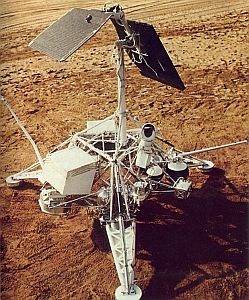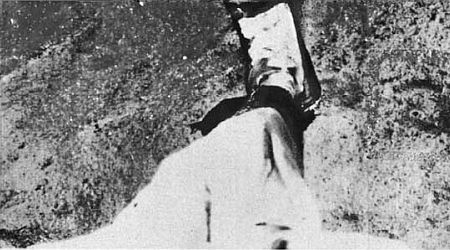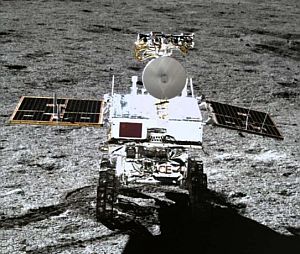
Für eine deutsche Übersetzung dieser Seite einfach die Brandenburger Flagge anklicken
 |
Click the Brandenburg Flag for a German translation Für eine deutsche Übersetzung dieser Seite einfach die Brandenburger Flagge anklicken |


|
|
MoonA collection of pictures of the Lunar surface,
|
|


 |
On February 3, 1966 the Soviet probe Luna 9 conducted the first soft landing of a human-built object on
an extraterrestrial world. The probe transmitted the first pictures taken directly on the surface of the Moon. The first American probe, Surveyor 1 landed on June 2, 1966. Here are our favorite pictures of the Lunar surface.
Artist's rendering of Luna 9 on the Moon |

|
Like our other space galleries, the pictures have not been selected because
of their scientific significance but because of their esthetic value and sometimes because of their historical importance.
|


|
After 13 failed attempts, of which only three reached the moon, but didn't succeed in a soft landing, Luna 9 beat the Americans by four months.
After being fired upwards from the lander shortly before impact, Luna 9's landing probe used a rather crude airbag system for the landing. On 3 February 1966, the landing probe reached the surface in Oceanus Procellarum. It bounced several times before coming to rest west of Reiner and Marius craters at approximately 7.08 N, 64.37 W at 18:45:30 UTC. |
  Model of Luna 9 Source: space.com |
  Luna 9 making headlines Source: Fitchburg Sentennial |

 |
 |
 Parts of the first panoramic image taken on the surface of the moon, Luna 9, February 3, 1966 Source: Andrew LePage
|


|
The first soft landing of an American probe took place on June 2, 1966, when Surveyor 1 landed in
the Ocean of Storms. In the following 18 month, four more Surveyor probes conducted successful landings. Surveyor 3 landed on April 20, 1967 in the Ocean of Storms. On November 19, 1969, Apollo 12's Lunar Module landed close to Surveyor 3, giving us the first direct photographs of an unmanned probe resting on another celestial body. Surveyor 5 landed on September 11, 1967 in the Sea of Tranquility, Surveyor 6 landed on November 7, 1967 in the Bay of the Center and Surveyor 7 landed on January 10, 1968 near the crater Tycho. |
  Model of Surveyor 1 Source: NASA |
  digitized panoramic image taken by Surveyor 1; Source: NASA / Planetary Society |


 digitized panoramic image taken by Surveyor 1 Source: NASA / Planetary Society |

  Surveyor 3, photographed by Apollo 12 crew Source: Wikipedia |
  Charles Conrad next to Surveyor 3 with the Apollo 12 LEM in the background; Source: Wikipedia |
  Panoramic image taken by Surveyor 5 Source: Wikipedia |

 |

|
|
Closeup image of Surveyour 3's landing site Source: Wikipedia |
Composite image of Surveyor 7's landing site Source: NASA / Planetary Society |


|
On November 17, 1970, a year after the first manned Moon landing, the Soviet Union landed the first Moon rover,
Lunokhod 1 (carried by
Luna 17) in the
Sea of Rains. It was the first remote-controlled robot vehicle to freely move
across the surface of an astronomical object beyond the Earth. For the next 321 days, the rover would travel 6.55 miles, conduct 25 soil analysis and take more than 20,000 pictures, among them 206 high-resolution panoramas. On January 15, 1973, the Soviet probe Luna 21 delivered rover Lunokhod 2 to the crater Le Monnier. Contact with the rover was lost on May 11, 1973. In only four months, Lunokhod 2 traveled 24 miles (39 km) through the Sea of Serenity - still the longest distance logged by any vehicle on the moon to date. Lunokhod 2 delivered 86 panoramic images and over 80,000 TV pictures. XXXXXXXXXXXXXXXXXXXXXX Model of Lunokhod 1; Source: Wikipedia |

|

  The tracks of Lunokhod 1 after leaving the lander Source: forum.kosmonauta
|

|
following the success of Luna 9, the Soviet Union conducted another soft landing on December 24, 1966.
Luna 13 landed in the Ocean of Storms and
sent five cyclopanoramic images. In the 1970s, the Soviet Union conducted three successful automatic sample return missions. Luna 16 landed in the Sea of Fertility on September 20, 1970. The probe landed at night and didn't deliver any pictures as the artificial illumination failed. It was, however, the fist successful automatic sample return mission from any place beyond earth. Luna 20 landed on February 21, 1972 in the Apollonius highlands and delivered a number of pictures of the landing site and the sample collection area. Luna 24, which landed in the Sea of Cises on August 18 1976, did not carry a camera.
|
 |

|
|
Panoramic image taken by Luna 13, December 24, 1966 source: Don P. Mitchell |
Luna 20 drilling site, February 21, 1972. source: Don P. Mitchell |


|
Luna 24 was the last Moon probe of the Space Race. Over 37 years would pass, before the
next space craft would touch down on the Moon.
On December 1, 2013, China launched |


 360-degree panorama taken by the Chang'e 3 lander showing tracks of the Yutu 1 rover. December 17, 2013, three days after landing. Source: Chinese Academy of Sciences / Planetary Society
|
| The lander deployed the Yutu rover. Due to mechanical problems, the rover only traveled a total distance of 377 feet (114.8 m). |

 |

|
|
Photo of Chang’e-3 moon lander taken by the Yutu rover, on December 22, 2013 Source: Chinese Academy of Sciences / universetoday.com |
First images of lunar landscape from Chang'e 3 lander, December 15, 2013 Source: Chinese Academy of Sciences / Planetary Society |



|

|
XXXXXXXXXXXXXXXFar side of the Moon On January 3, 2019 at 02:26 UTC, the Chinese probe Chang'e 4 performed the first automatic soft landing on the far side of the moon, touching down in the Moon's South Pole–Aitken basin inside the Von Kármán crater. Shortly after landing, the probe deployed the small rover Yutu 2 (picture right, source: spacenews.com). During the first three sunlight circles, the rover traveled 186 meters. Above is a panoramic view of the landing site with the rover in the distance (Source: Wikipedia). Below are the first picture taken of the surface of the far side of the Moon and two pictures of the Yutu 2 rover leaving Chang'e 4. |

|

 Source: physicsworld.com |

 |
 Source: theconversation.com |


|
During the Apollo program, twelve men walked on the moon and - among other things - took a huge number of amazing pictures. We devoted an extra site to the manned missions. |

|


|
|
Click here to return to Lunar orbit | Click here to move on to the Apollo missions |
|

|
Back to Solar System Page |
Back to Space Page |
Back to English Main Page |
 Back to Start Page |